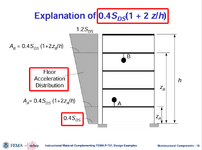Thank you for the additional feedback. I studied your PDF as well as Chapters 11 and 13 in ASCE 7-16.
From Chapter 11, Figure 11.4-1 and Eqn. 11.4-5 tells how to calculate acceleration below T_o. So when T = 0, ground acceleration is 0.4*S_DS. Units are in g's as shown in Figure 11.4-1. Taking a look at Eqn. 13.3-1, as you move vertically through the building, (1 + 2*z/h) linearly increases the acceleration. So at its max, (1 + 2*z/h) must equal 3, which means the max acceleration at the roof is 1.2*S_DS. This tells me the acceleration for the building ranges between 0.4*S_DS and 1.2*S_DS (this is confirmed in ASCE 7-16 §C13.3 also). By deduction, the other coefficients in Eqn. 13.3-1, except for W_p being the object's weight, are modifiers on the acceleration based on component importance, building height, etc.
With that said, I believe my original understanding in my first post is correct, but do remain open to counter statements.

